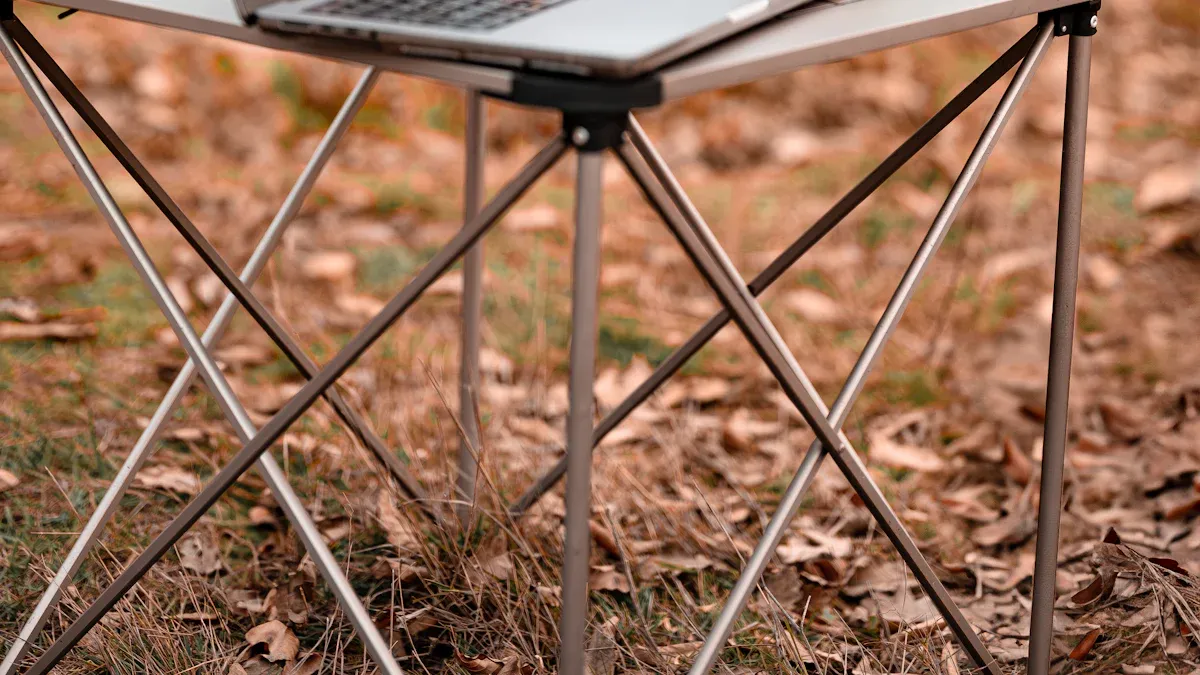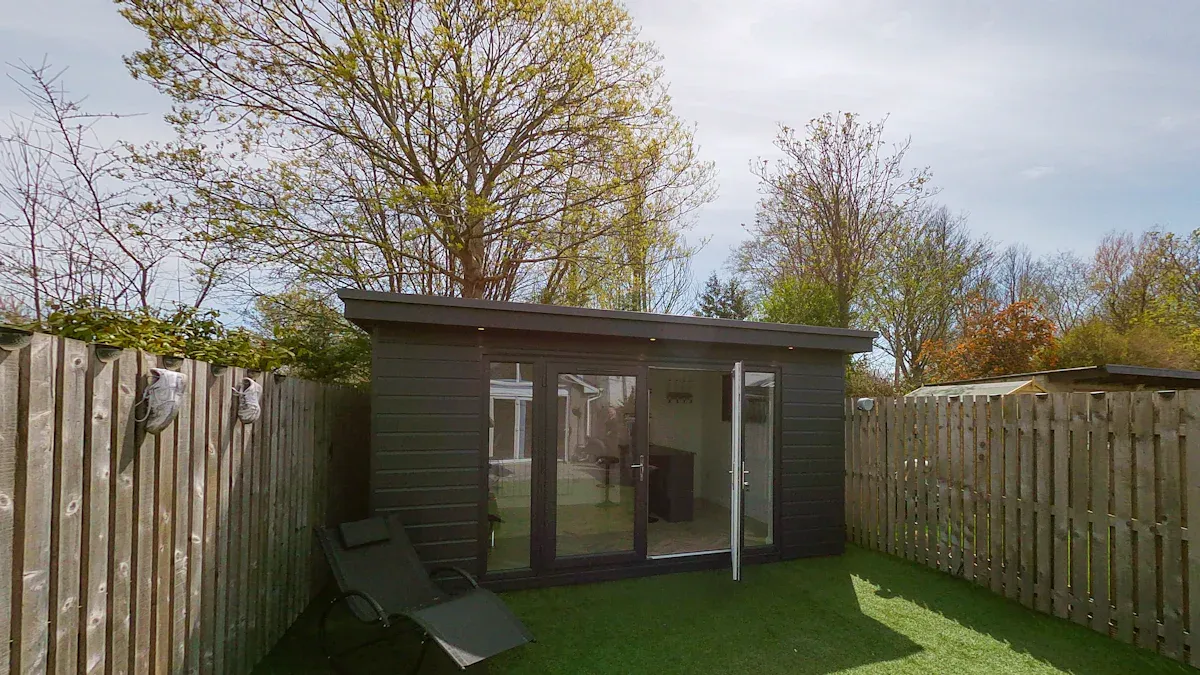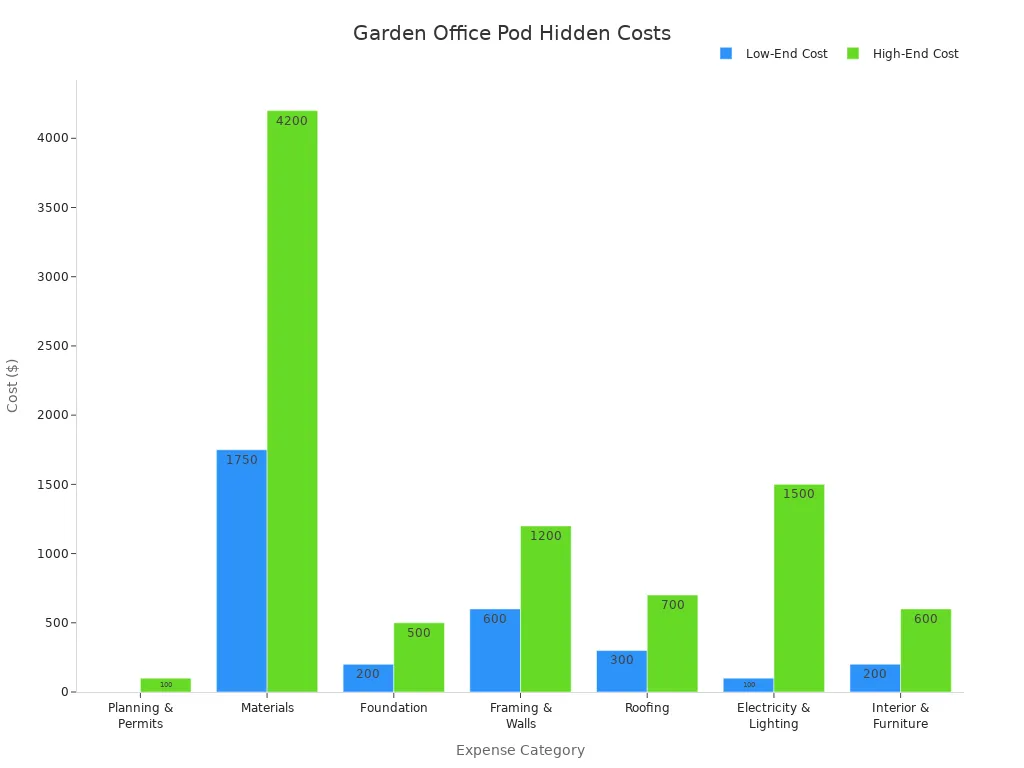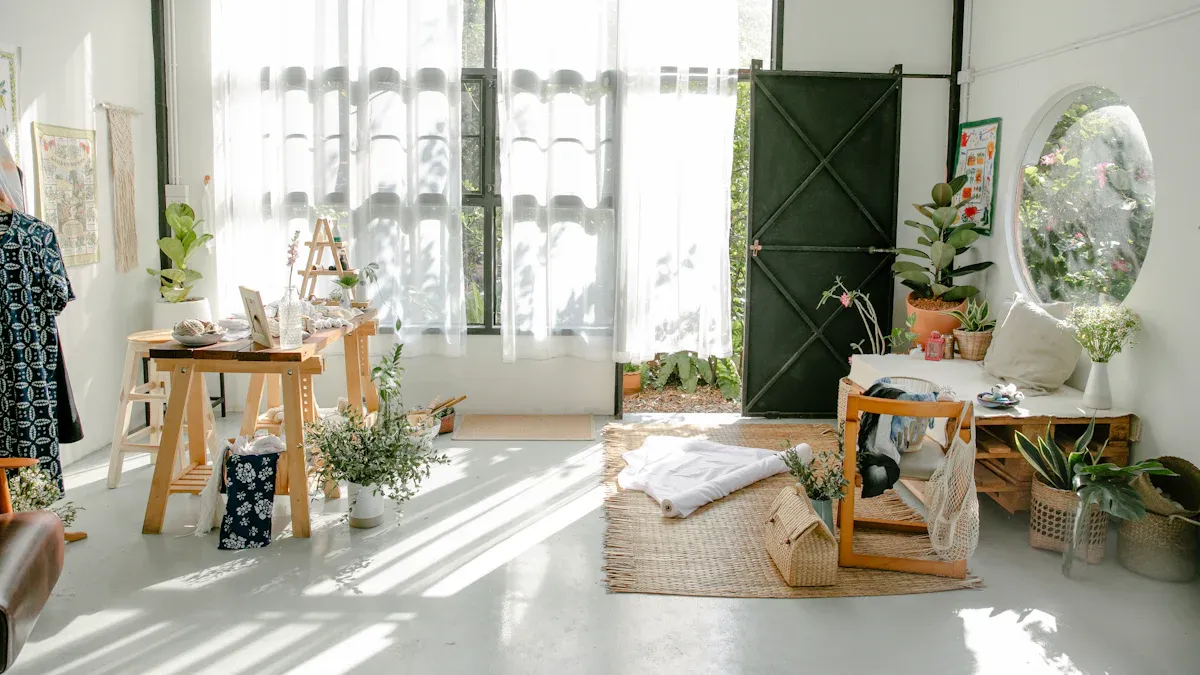
Discover how to build an ideal Garden Pod Office in 2025 without breaking the bank. This guide offers practical, budget-friendly strategies for creating a functional and inspiring workspace. Consider versatile options like portable work pods, which can serve as a quiet meeting phone booth or a focused soundproof study pod.
Key Takeaways
- A garden office pod boosts your work focus and separates work from home life. This helps you feel less stressed and more productive.
- You can save money by building a garden office pod. It costs less over time than renting an office. It also adds value to your home.
- Plan your garden office carefully. Set a budget, check local rules, and choose between DIY or a kit. You can use affordable materials like recycled wood to save even more.
Why a Budget Garden Pod Office is a Smart Investment

Boosting Productivity and Work-Life Balance
A dedicated workspace significantly enhances productivity. Individuals experience lower stress levels and a more positive attitude when working in a well-designed environment. Studies show that views of natural elements, such as greenery, improve well-being and job satisfaction. This connection to nature directly links to enhanced workability. A separate Garden Pod Office also creates a clear division between professional and personal life.
This clear division helps reduce the stress caused by blurred lines between work and personal life, supporting mental health by allowing the brain to distinctly process work and rest periods. Establishing routines, like a brief walk before entering the office, signals the start of focused work. Closing the door at the end of the day provides a psychological break. This reinforces healthy boundaries, reduces burnout, and improves presence in both work and family roles.
Cost-Effectiveness vs. Renting Office Space
A garden office pod offers a more cost-effective solution over time compared to renting commercial office space. It involves a one-time upfront cost for installation and minimal ongoing expenses for utilities. Commercial co-working spaces, however, require continuous monthly or yearly subscription fees. These fees, along with potential extra charges, accumulate into significant long-term costs. Many buyers can offset the entire purchase cost within 3–5 years by eliminating monthly lease payments. This indicates a typical return on investment period of three to five years.
Adding Value to Your Property
A well-built garden office pod is a valuable asset. A professionally designed pod can increase a property’s value by 5-10%. This makes it a worthwhile investment for homeowners seeking additional space. Several factors influence this value increase. Quality of construction ensures durability and longevity. A design that complements the home and garden maximizes natural light and views. Planning for essential utilities like electricity and Wi-Fi enhances functionality. Multi-purpose use and adaptability also appeal to potential buyers, future-proofing the property.
Planning Your Affordable Garden Pod Office: The Essentials
Setting a Realistic Budget for Your 2025 Garden Pod Office
Establishing a clear budget is the first step for any successful project. Many hidden costs can arise during construction. These include expenses for local rules and permits, foundation and anchoring, and power and data installation. Heating, cooling, and ventilation systems also add to the overall cost. Insulation and glazing choices significantly impact the budget. The size and layout of the structure, along with lighting and acoustics, also influence expenses. Consider potential costs for delivery and site access.

Assessing Your Space and Needs for a Garden Pod Office
Evaluate your available garden space carefully. A mini office measuring 1.8m x 2.4m provides sufficient room for a single desk worker. Consider essential features for your workspace. Prioritize size and location for optimal use and scenic views. Integrate technological infrastructure for AV equipment and critical office technology. Invest in ergonomic furnishings to reduce strain. Ensure multi-season climate control with proper insulation and windows for year-round comfort. Quality construction with weather-resistant materials is also important.
Understanding Planning Permissions and Regulations for Garden Pod Offices
Verify compliance with all regulations before starting construction. Planning permission is often not required for garden rooms. However, specific conditions apply. The structure must not exceed 2.5 meters in height. It should not block light or access to other properties. It must also occupy no more than half of your garden space. Most garden buildings under 15 square meters without sleeping accommodation are exempt from building regulations. Structures between 15 and 30 square meters may also be exempt if built from non-combustible materials and placed at least one meter from the boundary.
DIY vs. Kit vs. Professional Build: Which Saves You Money on Your Garden Pod Office?
The choice between DIY, a kit, or a professional build impacts costs significantly. DIY projects using only materials can range from $1,325 to $3,100 for a wooden 10×10 ft structure. Professionally installed wooden structures cost between $3,000 and $7,500. Metal options are $2,500 to $6,000. Vinyl builds range from $3,000 to $8,500. Brick structures cost $3,500 to $6,500. Kit builds offer a middle ground, providing pre-fabricated components for easier assembly. Hiring professionals like electricians ($50-$100/hr) or carpenters ($22-$25/hr) adds labor costs.
Top Budget-Friendly Garden Pod Office Ideas for 2025
Creating a dedicated workspace does not require a large budget. Many innovative and cost-effective solutions exist for building a functional and inspiring Garden Pod Office. These ideas focus on smart planning and resourcefulness.
Repurposing Existing Structures for Your Garden Pod Office
One of the most economical approaches involves transforming an existing structure. This method saves significant costs on new construction materials and foundations. Individuals can look at various options already present on their property.
- Attic Conversion: This option works well when outdoor space is limited. An attic can become a garden-facing workspace. Large windows or sliding doors connect the interior with the garden view.
- Converted Garden Shed: A standard garden shed offers a prime candidate for repurposing. Owners can transform it into a functional office. This transformation involves adding insulation, electricity, and proper furnishings. This choice is ideal for budget-conscious individuals who prefer a DIY approach.
Flat-Pack Kits: Affordable and Easy Assembly Garden Pod Office Options
Flat-pack kits provide a convenient and cost-effective solution. These kits arrive with pre-cut components. Builders can assemble them on-site. This method significantly reduces labor costs. Many companies offer various sizes and designs. They cater to different needs and budgets. Flat-pack kits often include all necessary materials. This simplifies the purchasing process. They also ensure a consistent quality of construction.
DIY Builds with Reclaimed and Sustainable Materials for a Garden Pod Office
Building a garden office from scratch allows for maximum customization and cost control. Using reclaimed and sustainable materials further reduces expenses and environmental impact. This approach requires more time and effort. It offers a unique and personalized workspace.
- Common sources for these materials include:
- Reclaimed timber
- Recycled steel
- Eco-friendly insulation
- Reclaimed wood
- Eco-friendly composites
These materials often come from demolition sites or local suppliers. They provide character and a story to the finished structure.
Modular Designs for Scalability and Cost Control in Your Garden Pod Office
Modular designs offer flexibility and long-term savings. These structures consist of pre-fabricated sections. Workers can easily assemble or disassemble them. This design approach contributes to long-term cost control. Construction processes become faster and less expensive. Labor and material costs are reduced. The ability to relocate and reuse pods minimizes the need for new construction. Modular designs also offer cost savings through bulk purchasing of materials. Labor efficiency in factory settings further reduces expenses.
- Easy Expansion: Additional modules can be added with minimal disruption.
- Relocatable Structures: Modules can be relocated or repurposed as needs change.
This flexibility makes them suitable for expanding companies or dynamic work situations. Ningbo Cheerme Intelligent Furniture Co., Ltd. exemplifies this vision. They are a professional artificial intelligence office equipment manufacturer. Cheer Me has designed, developed, and manufactured office cabins since 2017. They aim to become a leader in digital rapid assembly room brands. The company commits to building a sustainable prefabricated housing ecosystem. This involves modular design, modular assembly, modular large-scale production, and modular recyclable products. Their focus is on high performance and excellent user experience. This saves overall costs for users and helps achieve carbon neutrality.
Creative Small-Space Solutions: Micro Garden Pod Offices
Even small gardens can accommodate a functional office space. Micro garden pods require innovative design solutions. These solutions maximize functionality within limited footprints.
- Interior Design for Functionality:
- Ergonomic Setup: Incorporate adjustable standing desks and ergonomic chairs. These promote good posture and reduce strain.
- Smart Storage: Utilize floating shelves, compact filing cabinets, and multi-purpose desks with built-in storage. Hidden compartments maximize vertical space and maintain a clutter-free environment.
- Lighting: Maximize natural light with large windows or skylights. Use warm LED task lighting and smart lighting systems for customizable brightness.
- Soundproofing: Employ acoustic panels, insulated walls, heavy curtains, or rugs. These minimize noise and create a focused workspace.
- Biophilic Design: Introduce indoor plants and natural textures. Examples include wood or earthy tones. These improve air quality and create a calming atmosphere.
- Exterior Design for Aesthetics and Functionality:
- Sleek Finishes: Use durable materials like wooden cladding or composite materials. A monochrome or neutral color palette creates a minimalist look.
- Eco-Friendly Materials: Implement green roofs for insulation. These blend with the environment. Use sustainably sourced materials like bamboo or reclaimed wood.
- Large Windows: Install floor-to-ceiling windows and sliding glass doors. These enhance natural light, ventilation, and connection to nature.
- Compact and Modular Designs: Opt for small, prefabricated pods for limited spaces. Modular designs allow for future expansion or repurposing.
Smart Material Choices to Cut Costs for Your Garden Pod Office
Building a functional and inspiring Garden Pod Office on a budget requires careful material selection. Smart choices can significantly reduce overall expenses without compromising quality or durability. Focusing on cost-effective and sustainable materials helps achieve both financial savings and environmental responsibility.
Sustainable and Recycled Materials for Your Garden Pod Office
Opting for sustainable and recycled materials offers a dual benefit: it lowers costs and reduces environmental impact. These materials often possess unique character and can be sourced locally, further cutting transportation expenses.
- Salvaged Wood Floors: These floors are eco-friendly and often locally sourced. They repurpose existing materials, adding character and history to the space.
- Recycled Glass Tiles: Made from recycled glass, these tiles reduce environmental impact. They are low maintenance, scratch-resistant, and easy to clean for countertops, backsplashes, and flooring.
- Paperstone Countertops: Composed of recycled paper and cement, these countertops effectively reduce the carbon footprint of the build.
- Reclaimed Brick Veneer Tile: Made from salvaged old bricks, this tile is easy to install and durable. It suits accent walls or exterior cladding.
- Soy-Based Spray Foam Insulation: This insulation is energy-efficient and versatile. Its soy-based filler component lowers CO2 pollution.
- Hemp (Hempcrete): A mix of lime, water, and hemp shivs, hempcrete offers strength, durability, and fireproof properties. It is also mold-resistant and provides good insulation with an R-value of 2-3.
- Recycled Concrete Aggregate (RCA): Workers produce RCA from crushed recycled concrete pieces mixed with new concrete ingredients. This material can be used for foundations or pathways.
Cost-Effective Cladding Options for Your Garden Pod Office
Cladding protects the exterior of the garden office and contributes to its aesthetic appeal. Selecting budget-friendly options can significantly impact the total cost.
For budget-conscious projects, vinyl (PVC) cladding is frequently the most cost-effective option. While its durability and insulation properties may not match other materials, WPC cladding offers a natural appearance, cost-effectiveness, and balanced overall performance.
| Cladding Material | Material Cost |
|---|---|
| Vinyl Cladding | Low |
| Composite Cladding (WPC) | Low to Medium |
Entry-level cladding options, such as basic WPC/PVC panels, are available in the range of $0.78-$2.62 per meter. PU/Phenolic panels are priced between $0.80-$4.29 per square meter. These options provide a durable exterior without excessive expenditure.
Budget-Friendly Insulation for Your Garden Pod Office
Proper insulation is crucial for maintaining a comfortable temperature inside the garden office year-round. It also reduces heating and cooling costs. Choosing cost-effective insulation materials helps keep the budget in check. Soy-based spray foam insulation, as mentioned earlier, offers an energy-efficient solution with environmental benefits. Hempcrete also provides excellent insulation properties, contributing to a stable internal climate. Other budget-friendly options include fiberglass batts or mineral wool, which offer good thermal performance at a lower price point. Installing insulation correctly maximizes its effectiveness and prevents energy loss.
Smart Window and Door Sourcing for Your Garden Pod Office
Windows and doors are significant components of any building project. They impact both the cost and the energy efficiency of the garden office. Strategic sourcing can lead to substantial savings.
- Balance window size with budget constraints. Larger windows often cost more.
- Consider double-glazed, energy-efficient windows to improve insulation without excessive cost. These windows help regulate indoor temperatures, reducing the need for extensive heating or cooling.
Look for standard-sized windows and doors, as custom sizes typically incur higher costs. Salvage yards or architectural reclamation centers can also offer unique and affordable options. These items may require some refurbishment but can add character and save money. Prioritize functionality and energy efficiency over purely aesthetic choices when working with a tight budget.
Essential Interior Fit-Out for Your Garden Pod Office on a Shoestring Budget

Maximizing Space with Clever Furniture in Your Garden Pod Office
Maximizing space in a small office requires smart furniture choices. Multi-functional pieces are crucial for compact areas. They help maintain an uncluttered environment. This creates a perception of spaciousness.
| Furniture Piece | Functionality | Benefits |
|---|---|---|
| Wall-Mounted Desk | Saves floor space | Creates a sense of openness, ideal for small sheds |
| Murphy Desk | Folds up against the wall when not in use | Frees up space for other activities |
| Storage Ottoman | Offers storage and versatility | Keeps workspace organized, adaptable to different needs |
| Desk with Built-in Drawers | Offers storage and versatility | Keeps workspace organized, adaptable to different needs |
Other versatile options include fold-down tables and slide-out workspaces. These items adapt to various needs.
Budget Lighting Solutions for Your Garden Pod Office
Effective lighting enhances productivity without high costs. Energy-efficient options reduce electricity bills.
- Light-Emitting Diodes (LEDs): These are sustainable and cost less. They last longer than conventional bulbs.
- Compact Fluorescent Lamps (CFLs): CFLs save up to 80% on energy. They have a lifespan up to ten times longer than incandescent bulbs.
- Task Lighting: This method provides focused light for specific work areas. It reduces the need for extensive overhead lighting. This can lead to energy bill savings of up to 50%.
- LED Retrofit Kits: These kits offer an affordable way to upgrade existing fixtures.
Heating and Cooling Your Garden Pod Office Without Breaking the Bank
Maintaining a comfortable temperature is essential. Cost-effective heating solutions depend on usage and insulation.
| Heating Solution | Pros | Cons |
|---|---|---|
| Infrared Heating Panels | Efficient, quick, low operating costs | Higher upfront cost, limited heating range |
| Heat Pumps | Extremely efficient, long-term savings | Higher installation cost, potential planning permission |
| Wood-Burning Stoves | Cosy, effective for small spaces, low operating costs | Requires wood storage, regular cleaning |
| Portable Heaters | Low initial cost, portable | Higher running costs if frequent, not ideal for large/poorly insulated |
| Solar Heating Solutions | Reduces long-term energy costs, eco-friendly | High initial installation cost, depends on sunlight |
For regularly used, well-insulated spaces, an electric radiator or heat pump offers efficiency. For occasional use, a portable heater might suffice.
DIY Decor and Organization Hacks for Your Garden Pod Office
Personalizing the space on a budget is simple with DIY hacks.
- Repurposing with Spray Paint: Utilize spray paint to refresh old items. This includes patio chairs, plant pots, and furniture.
- Adding Plants: Incorporate plants like perennials or succulents. They enhance design and charm.
- Accessorizing like an Indoor Living Room: Add outdoor pillows, cushions, and string lights. An outdoor rug also creates a cozy atmosphere.
Long-Term Savings and Maintenance Tips for Your Garden Pod Office
Property owners can maximize the value and longevity of their garden office by implementing smart strategies. These approaches focus on reducing operational costs and ensuring the structure remains in excellent condition for years.
Energy Efficiency for Lower Running Costs of Your Garden Pod Office
Designing for energy efficiency significantly reduces long-term running costs. Double-glazed windows improve insulation, keeping the interior comfortable. LED lighting creates a bright, energy-efficient workspace. Smart heating solutions provide year-round comfort without excessive energy consumption. Strategic positioning avoids west-facing exposures for afternoon work sessions, preventing intense late-day sun and heat buildup. Natural light integration is crucial; position work surfaces to utilize indirect natural light while avoiding glare. Solar power systems offer a good return on investment, powering lighting, fans, small appliances, and even air conditioning. Rainwater harvesting systems reduce irrigation costs and provide backup water. Energy-efficient building materials, high-performance insulation, and ENERGY STAR appliances provide long-term savings. Effective shade management, such as retractable awnings, can significantly reduce outdoor temperatures.
Simple Maintenance to Extend Your Garden Pod Office Lifespan
Regular, simple maintenance protects the investment. Property owners should inspect the exterior cladding for any damage or wear. They must also clear gutters and downspouts to prevent water buildup. Checking seals around windows and doors helps maintain insulation and prevents drafts. A periodic cleaning of the exterior and interior keeps the space inviting and functional. Addressing minor issues promptly prevents them from escalating into costly repairs.
Future-Proofing Your Budget Garden Pod Office
Future-proofing involves designing the office with adaptability in mind. Consider modular designs that allow for easy expansion or reconfiguration if needs change. Ensure electrical and data infrastructure can support future technological upgrades. Choosing durable, high-quality materials for critical components extends the structure’s lifespan. This foresight ensures the office remains a valuable asset for many years.
Partnering with Experts for Your Garden Pod Office Needs
Building a budget-friendly workspace often benefits from expert guidance. Professionals offer specialized knowledge. They ensure quality and efficiency. Partnering with experienced manufacturers simplifies the process. This collaboration helps achieve a functional and inspiring office space.
Ningbo Cheerme Intelligent Furniture Co., Ltd.: Your AI Office Equipment Manufacturer
Ningbo Cheerme Intelligent Furniture Co., Ltd. stands as a professional artificial intelligence office equipment manufacturer. They bring extensive experience to the field. Since 2017, Cheer Me has designed, developed, and manufactured office cabins. Their expertise ensures high-quality products.
Cheer Me’s Vision for Sustainable Prefabricated Garden Pod Offices
Cheer Me holds a clear vision. They aim to become a leader in digital rapid assembly room brands. The company commits to building a sustainable prefabricated housing ecosystem. This ecosystem relies on modular design, modular assembly, and modular large-scale production. They also focus on modular recyclable products. Cheer Me prioritizes high performance and excellent user experience. This approach saves overall costs for users. It also helps achieve carbon neutrality.
Modular Design and Production for Cost-Effective Garden Pod Offices
Modular design and production are central to Cheer Me’s strategy. This method allows for efficient manufacturing. It reduces material waste. Modular components ensure quick and easy assembly on site. This significantly lowers labor costs. The standardized production process also guarantees consistent quality. Customers receive durable and reliable office solutions. These cost-effective methods make a dedicated workspace accessible to more individuals.
Building a budget-friendly garden office pod in 2025 is an achievable goal with significant returns. Smart planning, creative material sourcing, and a DIY spirit unlock an ideal workspace. Individuals transform their work-life balance and boost productivity without financial strain. This guide provides the tools for success.
FAQ
What is the average cost of a budget garden pod office?
Budget garden pod offices typically range from $1,325 to $3,100 for DIY wooden structures. Professional installations cost more. 💰
Do I need planning permission for a garden pod office?
Often, planning permission is not required.
The structure must be under 2.5 meters high and occupy less than half your garden space.
How can I make my garden pod office energy efficient?
Install double-glazed windows and LED lighting. Use smart heating solutions. Consider solar power for long-term savings.

